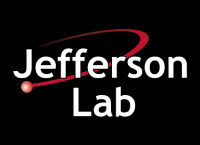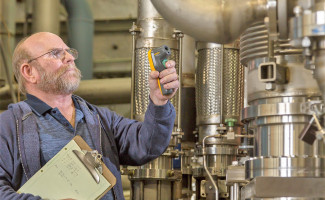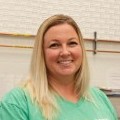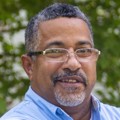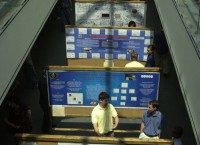Inventing Tools to Make Research Possible
At Jefferson Lab, ingenuity doesn't come solely from researchers; it exists at every level. Take Mechanical Technician Mark Stapleton, for example. When he learned that each of the 14 compressors that are critical to operations of the Continuous Electron Beam Accelerator Facility would have to be offline for a full week one compressor at a time every year for routine maintenance, he set out to find a solution to reduce the time spent offline. That is when he invented what is called an Axial Thrust Transmitter used to reduce downtime from one week to between four and eight hours.
How does Stapleton’s Axial Thrust Transmitter work? During his annual routine maintenance, Stapleton is looking for bearing wear that is as small as 0.0001 inches. To detect this wear, he first depressurizes the compressor and then inserts the Axial Thrust Transmitter into a port on the unit. The tool transmits the movement of the rotors to a dial indicator. If his system detects movement of more than 0.001 inches, he removes and rebuilds that section of the compressor.
Since then, he has made his career out of inventing tools and processes to keep the lab functioning efficiently.
As a member of Jefferson Lab’s Cryogenic Systems Department, Stapleton works with the compressors that power the Central Helium Liquefier, which is one of the largest refrigerators in the world. The CHL enables operations of the CEBAF accelerator, which is built on superconducting technology that must be cooled to within a few degrees of absolute zero (2 Kelvin) to function.
Another refrigerator, “The Cryogenic Test Facility, supports experimental processes for multiple laboratories,” Stapleton explains. “Individuals from around the world come to do their experiments and test their instrumentation so they can utilize those cold temperatures.”
The facility, Stapleton adds, has recently been enhanced. “We used to have expansion engine with two piston,” he says. “They are now in stand-by mode and we are running a cold box that has two expansion turbines, which takes high-pressure warm helium gas, spins it at remarkable speeds sending it back to a low-pressure side, colder and able to keep the multiple stages of Heat Exchangers at their optimum temperatures.” But when a seal failed on a Kinney Liquid Ring Pump, which is needed for 2K operation at the CTF, Stapleton noticed that the repair technician used a device that scratched the shaft. He then got to work inventing a tool that uses a clamp and screws to create a better hold, without damaging the Vacuum pumps shaft.
Stapleton is not only focused on ensuring scientists have the ideal set-up for conducting their experiments, but he is also focused on the cost-efficiency of his solutions. Since his first invention 23 years ago, his simple tool set has not only increased the online time of the CHL’s compressors by 50,000 hours, but it has also saved the lab an estimated $644,000. “The kit for doing the manufacturer’s check is $2,000,” Stapleton explains. Since 1993 CHL had six Howden Compressors now there are two CHL’s with a total of 14 compressors requiring the routine annual check, his Axial Thrust Transmitter has led to an annual savings of $28,000. “I like to think that we are saving taxpayers money,” says Stapleton.
Stapleton’s Play Shop
For Stapleton, finding new ways to make the complicated machinery at the lab run more efficiently crosses over into his off-hours time. He has a small “play machine shop” at his home where he enjoys tinkering. That passion for tinkering has impacted the lab in immeasurable ways.
Once, when a compressor failed, Stapleton worked with the manufacturer’s repair person to get it up and running again. “We disassembled one of the machines and found that the ball bearings had come apart and [the repair person] was showing us the steps he took to find out what was wrong with the compressor,” Stapleton explains. “I took some measurements and I went into my machine shop at home and machined up a new axial thrust tool. And then I made two more for different machines.”
Similarly, when a seal failed on a Howden compressor, Stapleton noticed that the repair technician used a device that scratched the shaft. Stapleton got to work inventing a tool that uses a vacuum pump and series of clamps and screws that creates a better seal without damaging the device’s shaft.
“I’m enjoying myself here,” says Stapleton. “I’m just a high school graduate, and this has been a school of training. And I’ve worked with the finest scientists in the world.”
Setting Sail
Stapleton, 62, is now tinkering with the idea of retirement so that he can spend more time with his wife and his personal projects. One of those projects has been building a 27’ mono-haul sailboat that is sitting in his back yard waiting for him to finish. The design of the boat was influenced by one of Stapleton’s colleagues at the lab who was once a leading windsurfer on the East Coast. “He gave me ideas on the keel design,” says Stapleton. “It’s a variable-weight, adjusted keel.” Stapleton does not plan to keep the sailboat, however, and just looks forward to finishing it so that he can find a new project to tackle.
While Stapleton may seem like an expert mechanical engineer, he shies away from that description. “One of my bosses used to call me an ‘expert,’” he says. “I don’t like that word, because I’m still learning. I’d rather be called a ‘’spert.’ I’m just a ‘spert—a simple drop of water in an ocean of ‘sperts.” When Stapleton does manage to retire, he knows that he will be leaving behind a community of the top ‘sperts in their fields and feels lucky to have been one of them.


